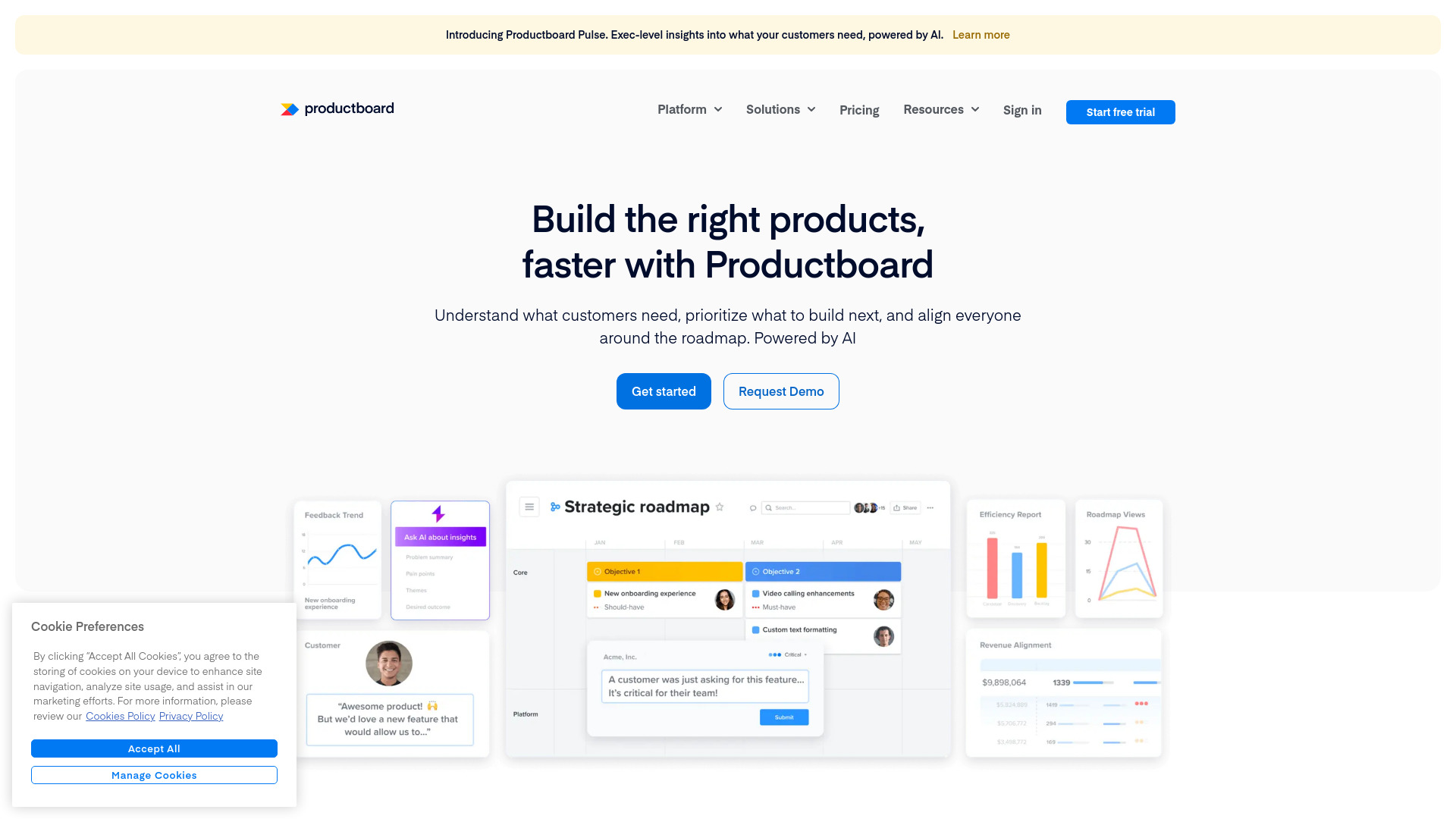- Home
- AI Product Manager
- Productboard

Productboard
Open Website-
Tool Introduction:Productboard AI turns feedback into priorities and aligned roadmaps.
-
Inclusion Date:Oct 21, 2025
-
Social Media & Email:
Tool Information
What is Productboard AI
Productboard AI is the intelligence layer of Productboard’s product management platform, built to turn raw customer feedback and product data into actionable insights. It helps teams capture signals from support conversations, surveys, and research, summarize themes, and link them to features and outcomes. With AI‑assisted prioritization and roadmap storytelling, it reduces manual triage and speeds up discovery, so product managers can focus on strategy, alignment, and delivering customer‑centric roadmaps. It also streamlines collaboration with consistent summaries, suggestions, and drafts across the product lifecycle.
Productboard AI Main Features
- AI insight summarization: Condenses large volumes of customer feedback into clear, theme‑based summaries to accelerate product discovery.
- Auto‑tagging and linkage: Suggests tags and links feedback to features, problems, and outcomes, keeping your backlog organized.
- Duplicate detection: Identifies similar requests and consolidates signals to reveal true demand and reduce noise.
- Prioritization assistance: Surfaces impact and effort cues and supports your chosen prioritization frameworks for data‑driven decisions.
- Spec and story drafting: Generates first drafts for problem statements, acceptance criteria, and release notes for faster iteration.
- Roadmap narratives: Helps craft concise roadmap summaries tailored to stakeholders for clearer alignment.
- Trend analysis: Highlights emerging themes across channels to inform strategy and product-market fit.
- Collaborative workflows: Brings AI suggestions into existing product management workflows for team review and approval.
Who Should Use Productboard AI
Ideal for product managers, product operations, UX researchers, and customer-facing teams who manage high volumes of feedback, prioritize features, and communicate roadmaps. It suits SaaS companies, B2B and B2C teams, startups, and enterprises seeking faster discovery, clearer prioritization, and consistent stakeholder updates.
How to Use Productboard AI
- Connect your feedback sources to centralize support tickets, survey responses, research notes, and feature requests.
- Ingest and categorize feedback; let AI summarize themes and suggest tags linked to features or problems.
- Review AI suggestions, refine tags, and merge duplicates to clean up your insights backlog.
- Use AI‑assisted cues to inform impact, effort, and confidence, then score and prioritize your roadmap items.
- Generate draft specs, user stories, or release notes from linked insights; edit for accuracy and context.
- Create roadmap narratives tailored to executives, sales, or engineering and share for alignment.
- Track outcomes, collect new feedback, and continuously refine priorities with AI‑supported insights.
Productboard AI Industry Use Cases
A B2B SaaS team triages thousands of tickets monthly; AI summarization reveals top friction points and maps them to features, enabling evidence‑based prioritization. An e‑commerce product team consolidates reviews and chat transcripts, using AI to detect seasonal demand shifts and adjust the roadmap. A fintech company drafts compliant release notes and stakeholder briefs faster by converting customer insights into clear, auditable narratives.
Productboard AI Pricing
Productboard is offered as a tiered, seat‑based subscription. Availability of Productboard AI depends on plan and entitlements. For current pricing, feature availability, and any trial options, refer to Productboard’s official pricing and documentation.
Productboard AI Pros and Cons
Pros:
- Speeds up product discovery with consistent, high‑quality summaries.
- Reduces manual triage by auto‑tagging and detecting duplicates.
- Improves prioritization with data‑driven cues and linked customer evidence.
- Enhances stakeholder alignment through clear, tailored roadmap narratives.
- Accelerates drafting of specs, user stories, and release notes.
Cons:
- AI suggestions require human review to ensure context and accuracy.
- Output quality depends on the volume and cleanliness of input data.
- Governance and data privacy considerations may require additional controls.
- Advanced capabilities may be limited to specific plans, impacting total cost.
- Change management is needed to embed AI workflows across teams.
Productboard AI FAQs
-
How does Productboard AI summarize customer feedback?
It uses AI models to extract themes, group similar requests, and generate concise summaries that link directly to features and outcomes.
-
Does it replace human prioritization?
No. It provides evidence and suggestions, but product managers make final prioritization decisions based on strategy and constraints.
-
Can it draft product specs or user stories?
Yes. It can create first drafts from linked insights to speed up documentation, which teams should review and refine.
-
What data sources can it analyze?
It works with feedback centralized in Productboard, including inputs from support, surveys, research notes, and other connected channels.
-
How does it support roadmapping?
By tying summarized insights to roadmap items, suggesting prioritization cues, and generating stakeholder‑ready roadmap narratives.



